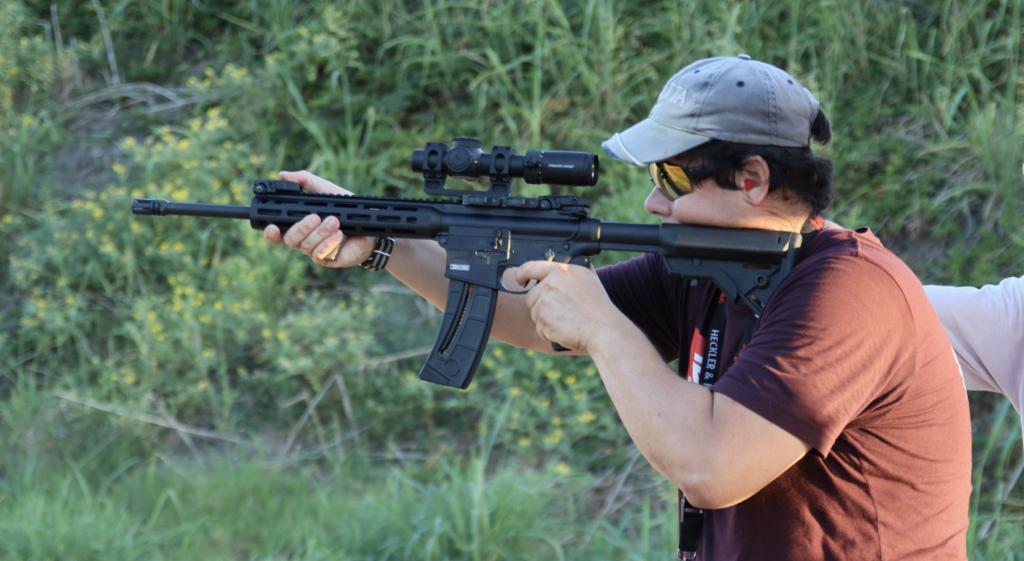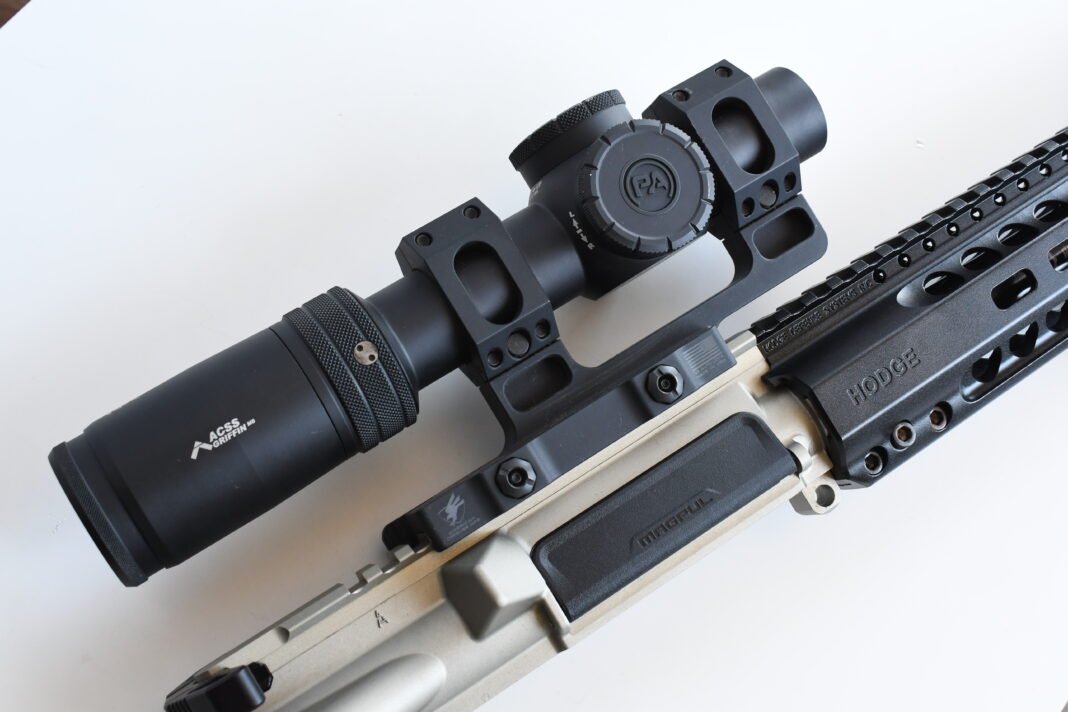The relatively new Primary Arms PLxC 1-8 LPVO riflescope got my attention after the US Department of Energy (DOE) began fielding it, and they entered into a contract with Primary Arms. It’s not just that certain armed DOE agents carry out interesting missions, but this is one of the first major contracts between Primary Arms Optics itself and the US Government. Beyond that, this is one of the most premium scopes sold by Primary Arms Optics to date.
The PLxC’s spec sheet is quite impressive, especially in terms of size, length, and weight. Although it was originally released in 2023, I was fortunate to get my hands on one of these compact LPVOs starting back in May to evaluate. Since then, this LPVO became my principal sidekick while shooting AR-pattern rifles.
I even took it to Cornerstone Performance’s Two-Day LPVO carbine course to stretch its legs out to 300 yards. It has also been my trusty side-kick at local Steel Challenge matches, atop a .22 LR Smith & Wesson M&P 15-22 carbine for the Rimfire Rifle Open Division.
Primary Arms Optics PLxC 1-8 LPVO Overview
The Primary Arms Optics PLxC 1-8x LPVO is a compact, low-power variable optic that is currently offered with three different reticle choices: the ACSS Griffin or ACSS Raptor (first focal plane), or the ACSS Nova Fiber Wire (second focal plane). This optic is built around a standard 30mm main tube diameter to keep it smaller and lighter. I find this intriguing as most LPVOs built around higher magnification levels and first focal plane reticles tend to use thicker 34mm bodies.
Because the PLxC is part of Primary Arms Optics’ premium tier, these units are manufactured specifically in Japan, under more stringent specifications. However, customers do pay for this accordingly as these optics retail for $1499. Aside from reticle or focal plane options, these LPVOs are available in both anodized black and anodized flat dark earth.
I have hands-on experience with the first focal plane unit that uses the ACSS Griffin Mil M8 reticle (the same SKU that’s furnished to the Dept. Of Energy under their contract).
A Solid Construction
Looking over my PLxC, it was easy to see how well-made the scope is. The magnification adjustment has finely machined knurling throughout its circumference. An L-shaped throw lever sits firmly secured via two Torx screws to the adjustment ring. The lever isn’t too tall and rotates 180 degrees, from 1x to 8x. At low-end or high-end, this means that the lever sits at either 9 or 3 o’clock. The resistance when twisting on the magnification adjustment ring feels about right, with a reasonable amount of snug resistance.
The rest of the PLxC’s peripherals, such as the turrets, turret caps, or diopter (focus) adjustment ring, are well fitted and also properly snug without any undo looseness. The clicks when turning the turrets are tactile, and I also appreciate the small detail of placing an o-ring around each turret’s circumference. This both seals off the elements and keeps the turret caps snugly closed.
From a physical standpoint, the fit, finish, and manner in which the controls correspond with the optic definitely have an “upmarket” feel to them.

Adjusting the Brightness
The “third” turret, what would typically be the traditional side-focus adjustment knob on a larger riflescope, serves as both the cradle for the CR 2032 coin battery and the control switch to turn the illumination on and off. This optic has ten different levels of illumination brightness, and it’s set up in the typical way, where every other click turns the array off.
Turning the illumination on or off takes deliberate effort, but it’s not impossible either. I say this is a good thing because LPVOs tend to be battery drains (just the facts of life), and no one wants their battery to be inadvertently drained because the dial loosely moved into the “on” position.
In the box, Primary Arms also includes a 30mm sunshade, and for those who may find it useful, an exposed elevation turret knob. By default, the optic is set up with capped turrets, but swapping from capped to exposed only involves loosening three tiny 1.3mm Allen screws and a simple switch.
Whether capped or exposed, those same three screws also allow the shooter to index the elevation knob on the 0-marking. This scope does not have a zero-locking feature, but I never found that to matter with its use case.
PLxC Exterior, Size, And Dimensions

The most notable thing about the Primary Arms Optics 1-8x PLxC LPVO is how “efficient” it is in size. Amongst modern first focal plane LPVOs, it’s one of the lightest, shortest, and most compact 30mm LPVOs currently available. For perspective, its closest rival is the 30mm Nightforce NX8 1-8 first focal plane LPVO, which also shares similar overall dimensions.
Off the top of my head, the only thing that’s possibly shorter than the PA PLxC would be the Vortex UK SOF 1-10 AMG LPVO, but those are purely made of unobtanium.
The PLxC weighs around 17 ounces and measures only 9.28 inches, which isn’t all that common for an LPVO with 8x magnification. At 17 ounces, it even bests several prominent 1-6 LPVO models. Paired with a QD 1.93” height ADM mount, this scope and mount weigh a combined total of 25 and ½ ounces, according to my coffee scale.
PLxC Japanese ED Glass
Primary Arms Optics builds PLxC LPVOs with Japanese-made ED (extreme dispersion) glass. Besides the size and weight, I’d argue that this ED glass is also one of the PLxC’s best features.
Looking through the glass during varying scenarios, I find it to be bright, crisp, and clear, with the “feel” of a more expensive scope. While I could pick up on some chromatic aberration with the magnification fully cranked at 8x when pointing a rifle at further targets, the purple fringing from this phenomenon wasn’t unreasonable and not dissimilar to chromatic aberration I’ve seen on more expensive glass.




